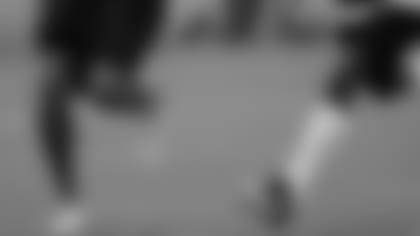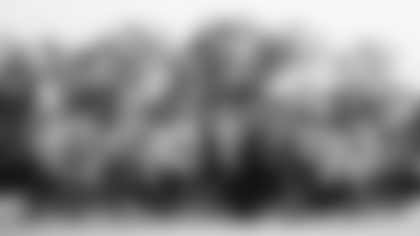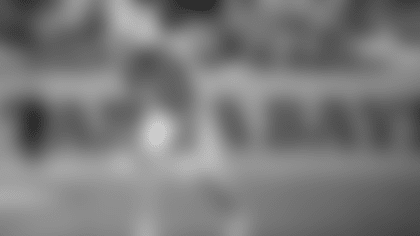Buccaneer players have found the young fields at the new facility to be in outstanding condition for practice
This is a story of gravel, sand, chopped grass and simple plastic pipe.
This is also a story of laser-grading, water conductivity specifications, embedded gas fumigation and around-the-clock maintenance.
Where simple digging in the dirt meets the science of cultivation you get the state-of-the-art practice fields recently created at the Tampa Bay Buccaneers' brand new training facility.
Think growing a big, rectangular patch of grass is just a matter of throwing down some seeds or rolling in some sod? Think again…and you'd better think well in advance. The Buccaneers needed every moment of the spring and summer to get these fields ready for play this fall.
There are many, many critical elements to the Buccaneers' enormous and intricately equipped new headquarters, but at the bottom of it, are any more important than the practice fields? If the Bucs had nowhere to run their plays, it wouldn't matter how well they studied, trained, rehabilitated or game-planned inside the facility's walls.
Thus, three football fields worth of grass have been taking root behind the facility since April 4, but that's only part of the process. Eight acres of athletic turf – roughly twice what the team had at One Buccaneer Place – have been constructed from the ground up on what was until recently the uncultivated grounds of a demolished shopping mall. Actually, they've been built from below the ground up.
The process began with a simple dig into the ground by an excavating contractor, and then a leveling that would form the basis for the very smooth, very level, slightly crowned field on the top. At the bottom, trenches were dug and filled with gravel, a fabric barrier and perforated pipes, all of which come together and empty into storm drains.
Above that was laid precisely four inches of gravel – laser-graded to within a quarter of an inch and selected scientifically based on such aspects as moisture-retention, water conductivity and particle size. The pipes for the field's irrigation system was laid at the top of this gravel level.
On top of that was laid the precise 12-inch root zone – what you or I would call "sand." However, simple sand doesn't retain water or nutrients, so this was actually an 80%-20% mixture of sand and Canadian peat. The choice of a root zone made of sand was to keep the fields playable 365 days a year.
"The reason people have gone to sand-based fields is for high performance in poor weather," said Bucs Groundskeeper Rob Julian. "They just drain so fast. You can play on them half an hour after rain, or even during the downpour, because they drain so well. In fact, it's almost to the point where they drain too well, as they can't hold water and nutrients. So it's a real challenge in sand-based fields to keep the nutrients up, which allows the grass to grow and establish itself."
It took an amazing 9,000 tons of the sand/peat mix to create this root zone across the three fields, requiring literally hundreds of dump-truck deliveries. Once it was in place and laser-graded in late March, another crew came in with a special tractor-mounted machine to inject gas chemicals into the root zone as a fumigation for insects, weeds and any other foreign objects. The field was covered for two days to keep the chemicals in. Once the cover came off, the field was ready for its crowning glory.
No sod here. The Bucs chose the more time-consuming method of using sprigs of Bermuda 419, which is in effect chewed-up sod stripped of the soil in which it was grown. Said Julian: "The most important thing about using sprigs is that you're actually growing the grass in your own medium. You're not getting it out of a sod farm that might have been a tomato farm or a strawberry patch. It's just loose grass and you're growing it in your medium."
Nearly 20,000 bushels of sprigs were spread by hand between the fourth and sixth of April, then cut an inch into the root zone to give it a better chance to take root. An intense period of fertilizing and watering followed with little help from Mother Nature and the dry, relatively cool spring in the Bay area. Six weeks later, on the 17th of May, the fields were mowed for the first time.
Now they're mowed every other day in anticipation of the imminent invasion of 80 very large men. Julian and various contractors have worked hard throughout the spring and summer giving the field every advantage they could, including verticutting, aerification, 500 additional tons of top-dressing and 15 tons of fertilizer. The fields have also been rolled three times with a three-ton double-drum roller, all in an effort to make them smoother and safer for Buccaneer players.
"No expense or effort was spared on this project," said Julian. "We were charged with creating the best athletic fields in all of sports, and we couldn't have done anything else to make it any better.
"We're proud of what we've done to this point. Now it's going to be an ongoing process as we make these fields better and stronger every year. We have to stay on top of that because we have to have a good, safe surface for our players to work on for years to come."
























